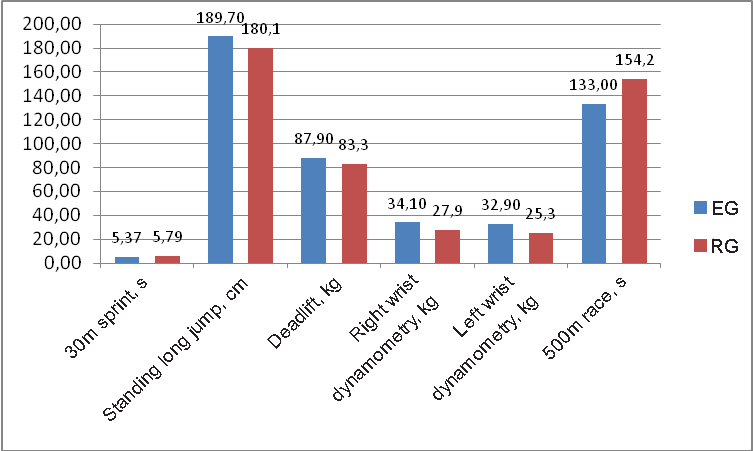Hapsagay wrestling basics mastering model for physical progress in deaf wrestling sport
ˑ:
PhD, Associate Professor V.S. Golokova1
Postgraduate student A.A. Olenova1
N.D. Nikolaev1
1Institute of Physical Culture and Sport of North-Eastern Federal University named after M.K. Ammosov, Yakutsk
Keywords: freestyle wrestling, hearing impairments, physical fitness, coordination abilities, Hapsagay wrestling, training process.
Background. Scientific research, educational process monitoring and physical progress tests of deaf preschooler population show the serious retardations in the speed-strength qualities and movement coordination abilities. This is the reason why the education community gives a special priority to these skills and abilities training models to facilitate their socializing and environmental adaptation. Benefits of the special speed-strength practices for this health group are underlined by the following theoretical provisions: (1) basic coordination abilities are defined as the movement coordination skills of special importance for everyday living – like walking, running, jumping, learning and other everyday needs serving abilities; and (2) progress in some physical ability normally triggers progress in other abilities, with this effect commonly referred to as the ‘positive transition’. Modern speed-strength training methods are generally governed by the coordination and physical conditioning progresses correlation principle. Such methods shall be complemented by the balancing, mental activation and hearing improvement tools for synergy of the correction process elements [1]. Focused speed-strength trainings are known to lay a basis for the physical progress and basic coordination qualities improvement initiatives [2].
Lately the national Sakha people’s sports including Hapsagay wrestling have been increasingly popular on the Republican, federal and international sport arenas, with their growing appeal in the communities. The local athletes competing in the events act to a degree as ambassadors of the healthy living styles and physical progress [3].
Objective of the study was to offer a Hapsagay wrestling basics mastering physical progress model for deaf wrestling.
Methods and structure of the study. The model testing educational experiment was run at the Republican Special Corrective Sport Base of Boarding School #1 in Yakutsk. Sampled for the experiment were the 11-13 year old deaf students (n=28) split up into Experimental and Reference Groups.The RG was trained by the standard method, and the EG trainings were complemented by the Hapsagay wrestling basics mastering course. The pre-experimental physicality and physical fitness tests found no meaningful intergroup differences.
The RG trainings were designed as required by the standard GYSS and CYORSS wrestling program approved by the State Committee Order #390 of 28.06.2001; and the EG trainings were complemented by the Hapsagay wrestling basics mastering course including Turgen (outside/ inside leg grab) hold; sweeping by foot in the under-arm grip position; sweeping by the outside of the foot with a twist; diving and sweeping; defense sweeping to prevent legs grip; pulling under with a false attack to the legs.
Results and discussion. The yearly Hapsagay wrestling basics mastering physical progress model testing experiment found a great and significant progress in the physical qualities in the EG versus RG. It should be noted that the RG made progress too although it was significantly lower than in the EG: see Figure 1.

Figure 1. EG and RG pre- versus post-experimental test data
30m sprint, s Standing long jump, cm Deadlift, kg Right wrist dynamometry, kg Left wrist dynamometry, kg 500m race, s
The pre- versus post-experimental tests showed the following progress: in the 30m sprint, the EG made progress of 0.73s (Т=11.96%) with the average of 5.37 ±0.14s 0=3.56; versus the RG progress of 0.45s (Т=7.21%) with the average of 5.79 ±0.15s 0=2.14. In the speed-strength rating standing long jump test, the EG made progress of 24.3cm (Т = 14.6%) with the average of 189.7±3.6cm; versus the RG progress of 15.4cm (Т = 9.35%) with the average of 180.1±3.2cm.
Furthermore, the general endurance rating 500m race test found the EG making progress of 44.4s (Т = 24.90%) versus 22.5s in the RG (Т = 12.7%) with the averages of 133.9±4.7s and 154.2±3.8s, respectively. The strength rating wrist dynamometric tests also found meaningful progress of the EG, with the right wrist strength improved by 16.9kg, with the average of 34.10±2.00kg, and the left wrist strength improved by 17.3kg, with the average of 32.90±2.20kg; versus the RG progress in the right wrist strength improved by 10.8kg (average rate of 27.90±2.10kg), and left wrist strength by 10.2kg (average rate of 25.30±1.8kg).
Conclusion. The Hapsagay wrestling basics mastering physical progress model for deaf underage wrestlers with a special priority to the speed-strength training elements was found highly beneficial as verified by the EG versus RG meaningful physical progress.
References
- Kartavtseva A.I., Aksenova O.E. Comprehensive restoration of adaptive physical education for hearing impaired children in preschool educational institutions. Study guide. M.: Sovetskiy sport publ., 2011. 156 p.
- Nikiforova N.V. Technical and tactical training of hapsagay wrestlers at initial stage in view of systematization of techniques. PhD diss. abstr. St. Petersburg, 2016.
- Torgovkin V.G., Uygurov V.V., Struchkov V.E. National wrestling hapsagay. Teaching aid. Yakutsk: NEFU publ., 2014. 92 p.
Corresponding author: yadruk@mail.ru
Abstract
Scientific research, educational process monitoring and physical progress tests of deaf preschooler population show the serious retardations in the speed-strength qualities and movement coordination abilities. These qualities and abilities are known to be fast developed by the modern freestyle wrestling sport which is increasingly popular worldwide as a powerful physical development and professional progress facilitating sport discipline of special effect on the muscular sensations and speed-strength aspects. Potential of the sport may be mobilized to find efficient progress models for the partially or completely deaf and other handicapped people. Objective of the study was to offer a Hapsagay wrestling basics mastering physical progress model for deaf wrestling. The model testing educational experiment was run at the Republican Special Corrective Sport Base of Boarding School #1 in Yakutsk. Sampled for the experiment were the 11-13 year old deaf students (n=28) split up into Experimental and Reference Groups. The RG was trained by the standard method, and the EG trainings were complemented by the Hapsagay wrestling basics mastering course.


